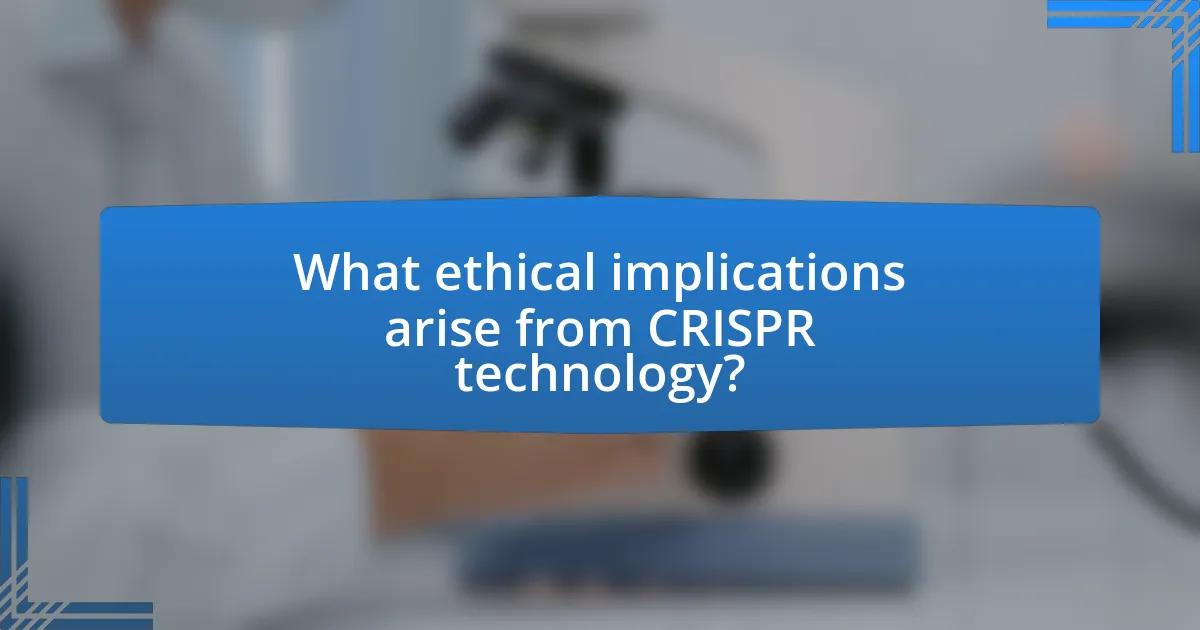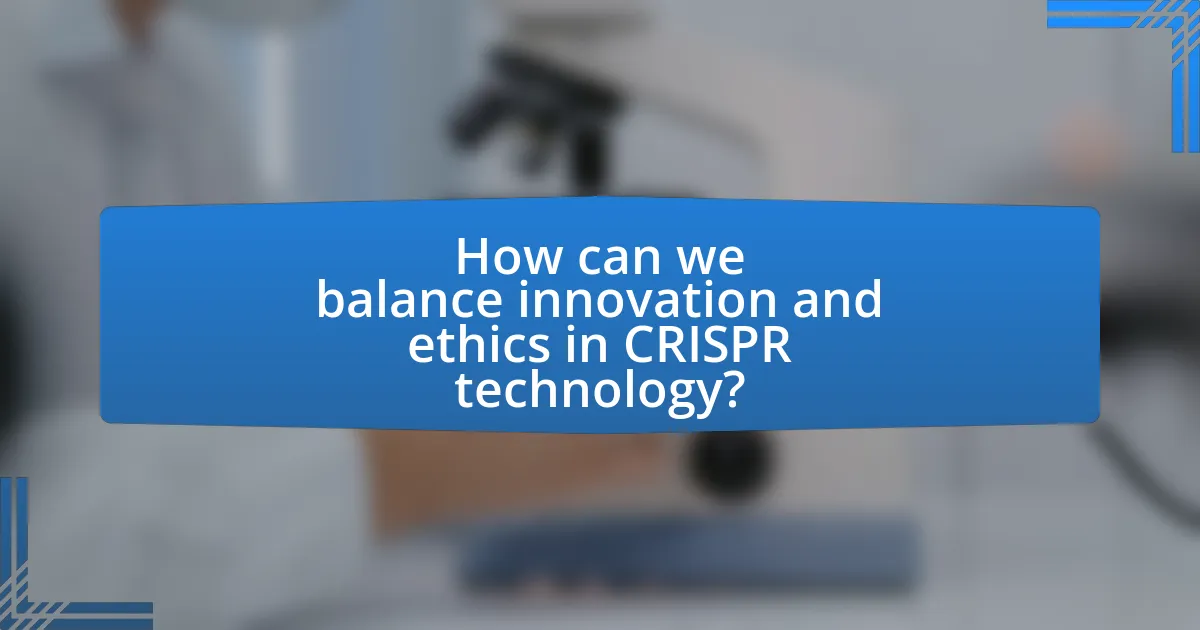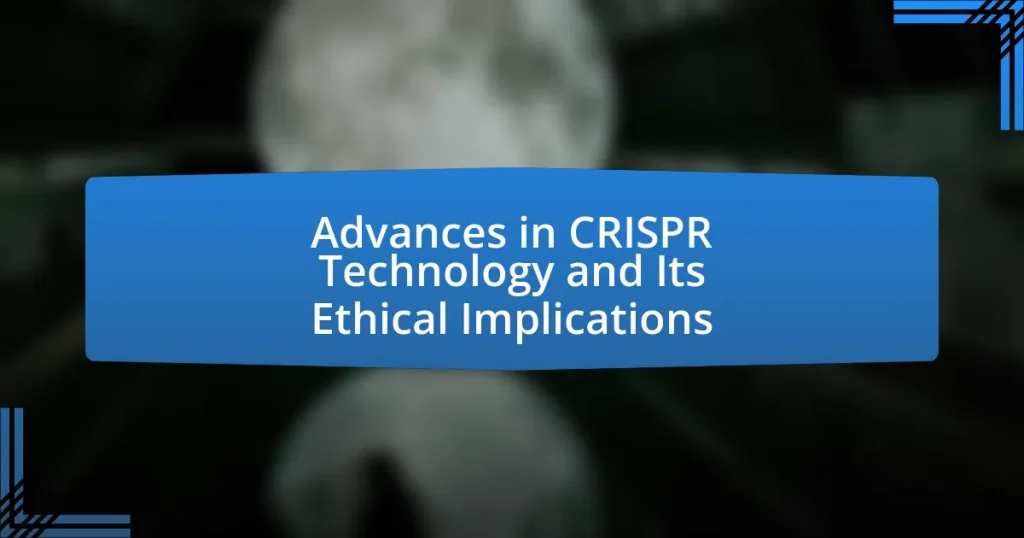The article focuses on recent advances in CRISPR technology and its ethical implications. It highlights developments such as enhanced CRISPR-Cas9 systems, base editing, and successful therapeutic applications for genetic disorders. The evolution of CRISPR over the past decade is discussed, along with key milestones, efficiency improvements, and diverse applications in medicine and agriculture. Ethical concerns surrounding gene editing, particularly in humans, are examined, emphasizing the need for robust regulatory frameworks to balance innovation with societal values. The article also addresses the implications of CRISPR advancements for future generations, underscoring the importance of responsible development and public engagement.

What are the recent advances in CRISPR technology?
Recent advances in CRISPR technology include the development of CRISPR-Cas9 systems with enhanced precision, such as CRISPR-Cas12 and CRISPR-Cas13, which allow for more targeted gene editing with reduced off-target effects. Additionally, researchers have made strides in base editing, a technique that enables the conversion of one DNA base pair into another without causing double-strand breaks, thus minimizing potential errors. A significant advancement is the application of CRISPR in therapeutic contexts, including successful trials for genetic disorders like sickle cell disease and beta-thalassemia, demonstrating its potential for clinical use. These advancements are supported by studies published in journals such as Nature and Science, highlighting the ongoing evolution and application of CRISPR technology in various fields.
How has CRISPR technology evolved over the past decade?
CRISPR technology has significantly advanced over the past decade, evolving from a basic gene-editing tool to a sophisticated platform for various applications, including therapeutic interventions and agricultural improvements. Initially, CRISPR was primarily utilized for genome editing in model organisms, but recent developments have expanded its use to human clinical trials, such as the treatment of genetic disorders like sickle cell disease and beta-thalassemia, demonstrating its potential for real-world medical applications. Furthermore, innovations like CRISPR-based diagnostics, including rapid tests for infectious diseases, have emerged, showcasing the versatility of the technology. The refinement of CRISPR systems, such as the development of CRISPR-Cas9 variants with enhanced specificity and reduced off-target effects, has also contributed to its evolution, making it a more reliable tool for researchers.
What are the key milestones in CRISPR development?
The key milestones in CRISPR development include the discovery of the CRISPR-Cas9 system in 2012, which was first demonstrated as a gene-editing tool by Jennifer Doudna and Emmanuelle Charpentier. This breakthrough allowed for precise modifications in DNA, revolutionizing genetic engineering. In 2013, the first successful application of CRISPR in human cells was reported, showcasing its potential for therapeutic uses. The subsequent years saw advancements in CRISPR technology, including the development of CRISPR-Cas12 and CRISPR-Cas13 systems, which expanded the range of applications. In 2020, Doudna and Charpentier were awarded the Nobel Prize in Chemistry for their pioneering work, solidifying CRISPR’s significance in biotechnology and medicine.
How have new techniques improved CRISPR’s efficiency?
New techniques have significantly improved CRISPR’s efficiency by enhancing target specificity and reducing off-target effects. Innovations such as the development of high-fidelity Cas9 variants, like SpCas9-HF1, have been shown to minimize unintended edits while maintaining robust editing capabilities, as evidenced by studies demonstrating a reduction in off-target activity by up to 90%. Additionally, advancements in delivery methods, such as the use of nanoparticles and viral vectors, have increased the precision and effectiveness of CRISPR systems in various cell types, leading to more successful gene editing outcomes in both research and therapeutic applications.
What are the different applications of CRISPR technology?
CRISPR technology has diverse applications across various fields, including medicine, agriculture, and biotechnology. In medicine, CRISPR is utilized for gene editing to treat genetic disorders such as sickle cell anemia and cystic fibrosis, with clinical trials demonstrating its potential effectiveness. In agriculture, CRISPR is employed to create genetically modified crops that are resistant to pests and diseases, enhancing food security and sustainability. Additionally, CRISPR is used in biotechnology for developing new tools for research, such as gene drives for controlling vector-borne diseases. These applications highlight CRISPR’s transformative impact on science and technology.
How is CRISPR used in agriculture?
CRISPR is used in agriculture to enhance crop traits, improve resistance to pests and diseases, and increase yield. This gene-editing technology allows for precise modifications in the DNA of plants, enabling the development of varieties that can withstand environmental stresses such as drought or salinity. For instance, researchers have successfully used CRISPR to create rice varieties with improved nutritional content and enhanced resistance to bacterial blight, demonstrating its potential to address food security challenges.
What role does CRISPR play in medical research?
CRISPR plays a pivotal role in medical research by enabling precise gene editing, which allows scientists to modify DNA sequences and regulate gene expression. This technology facilitates the investigation of genetic diseases, the development of gene therapies, and the creation of animal models for studying human diseases. For instance, CRISPR has been utilized in clinical trials to treat conditions such as sickle cell disease and beta-thalassemia, demonstrating its potential to correct genetic mutations. The ability to target specific genes with high accuracy significantly accelerates the pace of research and opens new avenues for therapeutic interventions.

What ethical implications arise from CRISPR technology?
CRISPR technology raises significant ethical implications, primarily concerning genetic modification, consent, and potential inequality. The ability to edit genes can lead to “designer babies,” where parents may choose traits for their children, raising concerns about eugenics and societal pressure to conform to certain genetic standards. Additionally, the lack of informed consent in genetic modifications, especially in germline editing, poses ethical dilemmas as future generations cannot consent to changes made to their DNA. Furthermore, the potential for unequal access to CRISPR technology could exacerbate existing social inequalities, creating a divide between those who can afford genetic enhancements and those who cannot. These implications highlight the need for robust ethical frameworks and regulations to guide the use of CRISPR technology responsibly.
Why is there concern over gene editing in humans?
There is concern over gene editing in humans primarily due to ethical implications, potential unintended consequences, and the risk of exacerbating social inequalities. Ethical concerns arise from the possibility of “designer babies,” where genetic modifications could lead to enhanced traits, raising questions about consent and the natural human experience. Additionally, unintended consequences, such as off-target effects where unintended genes are altered, could lead to unforeseen health issues. Research indicates that CRISPR technology, while promising, has shown instances of such off-target effects in studies, highlighting the need for caution. Furthermore, the potential for gene editing to widen the gap between socio-economic classes is significant, as access to these technologies may be limited to wealthier individuals, leading to a new form of inequality in health and capabilities.
What are the potential risks of germline editing?
The potential risks of germline editing include unintended genetic mutations, ethical concerns regarding eugenics, and long-term health effects on future generations. Unintended mutations can arise from off-target effects during the editing process, which may lead to new genetic disorders or health issues. Ethical concerns center around the possibility of creating “designer babies,” which raises questions about social inequality and the definition of normalcy. Additionally, the long-term consequences of germline modifications are unknown, as changes are passed down to subsequent generations, potentially leading to unforeseen health problems. These risks highlight the need for careful consideration and regulation in the application of germline editing technologies.
How do societal views influence the ethics of CRISPR use?
Societal views significantly influence the ethics of CRISPR use by shaping public perception and regulatory frameworks. Public opinion can lead to increased scrutiny and demand for ethical guidelines, as seen in debates surrounding gene editing for human enhancement versus disease prevention. For instance, a 2020 survey by the Pew Research Center found that 72% of Americans believe gene editing should be allowed to prevent serious diseases, but only 19% support its use for enhancing human traits. This disparity highlights how societal values dictate ethical boundaries, prompting policymakers to consider public sentiment when establishing regulations. Consequently, societal views serve as a critical factor in determining the ethical landscape of CRISPR applications.
What regulations exist for CRISPR technology?
CRISPR technology is regulated by various frameworks that differ by country and application. In the United States, the National Institutes of Health (NIH) oversees gene editing research involving human subjects, while the Food and Drug Administration (FDA) regulates gene therapies. The European Union has established the European Medicines Agency (EMA) to evaluate gene editing products, and the Cartagena Protocol on Biosafety governs the international movement of genetically modified organisms. These regulations ensure safety, ethical considerations, and compliance with scientific standards in the use of CRISPR technology.
How do different countries approach CRISPR legislation?
Different countries approach CRISPR legislation with varying degrees of regulation and permissiveness. For instance, the United States has a relatively permissive stance, allowing research and clinical applications under the oversight of the FDA and NIH, but it prohibits germline editing. In contrast, the European Union has stricter regulations, particularly under the European Convention on Human Rights, which limits genetic modifications that could affect future generations. China has rapidly advanced in CRISPR research, with less stringent regulations, but recent controversies have led to calls for more oversight. Countries like Japan and Canada have established frameworks that emphasize ethical considerations while permitting research, reflecting a balance between innovation and caution. These diverse approaches highlight the global debate on the ethical implications of CRISPR technology and the need for harmonized regulations.
What are the challenges in creating a global regulatory framework?
Creating a global regulatory framework faces significant challenges, primarily due to differing national interests and legal systems. Countries often prioritize their own economic, ethical, and cultural values, leading to inconsistencies in regulations regarding CRISPR technology. For instance, while some nations may embrace gene editing for agricultural advancements, others may impose strict bans due to ethical concerns. Additionally, the rapid pace of technological advancement outstrips the ability of regulatory bodies to keep up, resulting in gaps in oversight. The lack of international consensus on ethical standards further complicates the establishment of a cohesive framework, as seen in the varied approaches to human gene editing across different jurisdictions.

How can we balance innovation and ethics in CRISPR technology?
Balancing innovation and ethics in CRISPR technology requires establishing robust regulatory frameworks that prioritize safety and societal impact. Regulatory bodies, such as the National Institutes of Health and the World Health Organization, can guide research by setting ethical standards and ensuring transparency in gene editing applications. For instance, the 2015 Asilomar Conference on Recombinant DNA highlighted the importance of responsible research practices, leading to guidelines that promote ethical considerations in genetic engineering. Additionally, engaging diverse stakeholders, including ethicists, scientists, and the public, fosters a comprehensive dialogue that addresses potential risks and benefits, ensuring that advancements in CRISPR technology align with societal values and ethical norms.
What best practices can guide ethical CRISPR research?
Best practices that can guide ethical CRISPR research include ensuring transparency, engaging in public dialogue, and adhering to regulatory frameworks. Transparency involves openly sharing research goals, methods, and findings to foster trust and accountability. Engaging with diverse stakeholders, including ethicists, scientists, and the public, helps address societal concerns and ethical implications. Adhering to established regulatory frameworks, such as those set by the National Institutes of Health and the World Health Organization, ensures compliance with safety and ethical standards. These practices are supported by guidelines from organizations like the International Society for Stem Cell Research, which emphasizes the importance of ethical oversight in genetic research.
How can researchers ensure responsible use of CRISPR?
Researchers can ensure responsible use of CRISPR by adhering to ethical guidelines, conducting thorough risk assessments, and engaging in transparent communication with the public. Ethical guidelines, such as those established by the National Academy of Sciences, emphasize the importance of considering the long-term impacts of genetic modifications. Conducting risk assessments helps identify potential unintended consequences of CRISPR applications, ensuring that researchers evaluate both the benefits and risks before proceeding. Furthermore, transparent communication fosters public understanding and trust, allowing for informed discussions about the implications of CRISPR technology. These practices collectively promote accountability and ethical responsibility in genetic research.
What role do public discussions play in shaping CRISPR policies?
Public discussions play a crucial role in shaping CRISPR policies by facilitating dialogue among scientists, ethicists, policymakers, and the public. These discussions help to identify societal concerns, ethical dilemmas, and potential risks associated with CRISPR technology, which in turn influence regulatory frameworks. For instance, public forums and debates have highlighted issues such as gene editing in humans, leading to calls for stricter regulations and oversight. The 2018 case of the Chinese scientist He Jiankui, who created genetically edited babies, sparked global outrage and prompted discussions that have since informed international guidelines on gene editing. Such public engagement ensures that policies reflect a broad spectrum of values and ethical considerations, ultimately guiding responsible innovation in CRISPR applications.
What future directions should CRISPR technology take?
Future directions for CRISPR technology should focus on enhancing precision and reducing off-target effects. Current advancements aim to improve the specificity of CRISPR systems, such as the development of high-fidelity Cas9 variants, which have shown to significantly lower unintended edits in genomic sequences. Research published in Nature Biotechnology by Liu et al. (2019) demonstrated that these engineered variants can achieve up to 90% reduction in off-target activity compared to the wild-type Cas9. Additionally, expanding CRISPR applications to therapeutic uses, such as gene therapy for genetic disorders and cancer treatment, is crucial. The successful application of CRISPR in clinical trials, like the one reported by the New England Journal of Medicine in 2020, highlights its potential in treating sickle cell disease. Furthermore, addressing ethical implications through regulatory frameworks and public engagement will be essential to guide responsible use and societal acceptance of CRISPR technology.
How can CRISPR technology be developed responsibly?
CRISPR technology can be developed responsibly by implementing strict regulatory frameworks and ethical guidelines that govern its use. These frameworks should include comprehensive risk assessments, public engagement, and transparent decision-making processes to address potential societal impacts. For instance, the National Academy of Sciences emphasizes the importance of involving diverse stakeholders in discussions about gene editing to ensure that ethical considerations are prioritized alongside scientific advancements. Additionally, ongoing monitoring and evaluation of CRISPR applications can help mitigate unintended consequences, as highlighted in studies that show the potential for off-target effects in gene editing.
What are the implications of CRISPR advancements for future generations?
CRISPR advancements have significant implications for future generations, primarily in the areas of genetic disease prevention, agricultural enhancement, and ethical considerations. These technologies enable precise editing of genes, which can lead to the eradication of hereditary diseases such as cystic fibrosis and sickle cell anemia, potentially improving the quality of life for countless individuals. For instance, a study published in Nature in 2020 demonstrated successful CRISPR-based treatments in human trials for genetic disorders, showcasing the technology’s potential to alter disease trajectories.
Moreover, CRISPR can enhance agricultural productivity by creating crops that are more resistant to pests and climate change, thereby ensuring food security for future populations. Research from the International Food Policy Research Institute indicates that genetically modified crops can increase yields by up to 30%, which is crucial as the global population continues to rise.
However, these advancements also raise ethical concerns regarding genetic modification, including the potential for unintended consequences and the moral implications of “designer babies.” The ongoing debate emphasizes the need for regulatory frameworks to guide the responsible use of CRISPR technology, ensuring that its benefits are realized without compromising ethical standards. Thus, while CRISPR holds transformative potential for future generations, it necessitates careful consideration of its societal and ethical ramifications.


